- 1Paneureka, Le Bourget-du-Lac, France (lmontabone@paneureka.org)
- 2Laboratoire de Météorologie Dynamique/Sorbonne Université and Ecole Polytechnique, Paris, France
- 3Space Science Institute, Boulder, CO, USA
- 4European Space Astronomy Center, Madrid, Spain
- 5Instituto de AstroFisica e Ciencias do Spaço, Porto, Portugal
- 6AIKO S.R.L., Turin, Italy
- 7Imperial College, London, UK
- 8University of California/Space Sciences Laboratory, Berkeley, CA, USA
- 9European Space Research and Technology Centre, Noordwijk, Netherlands
- 10Politecnico di Milano, Milan, Italy
- 11Department of Physics & National Space Science and Technology Center, United Arab Emirates University, Al Ain, UAE
To date, Mars’s weather has been monitored mainly from spacecraft in polar or quasi-polar orbits, which sample only a narrow range of local times, or several local times over multiple sols with discontinuous spatial coverage (Fig.1). When observations have been made and/or analyzed at different local times, a high magnitude of diurnal variability often has been found [see e.g. 1 to 5]. The significance of diurnal meteorological variability at Mars argues for orbital observations that span the diurnal cycle. The rapid dynamics of meteorological phenomena such as dust storms (typical timescale of a few hours) and water/CO2 ice clouds (typical timescale of half an hour or less), together with their spatial extension (up to the planetary scale for dust events) and duration/repeatability, argues for continuous and simultaneous observations across the planet (Fig.1). As it happened for the study of meteorology on Earth in the 1970s, now is the right time to introduce monitoring to the observation paradigm for the martian atmosphere, so far almost exclusively focused on mapping.
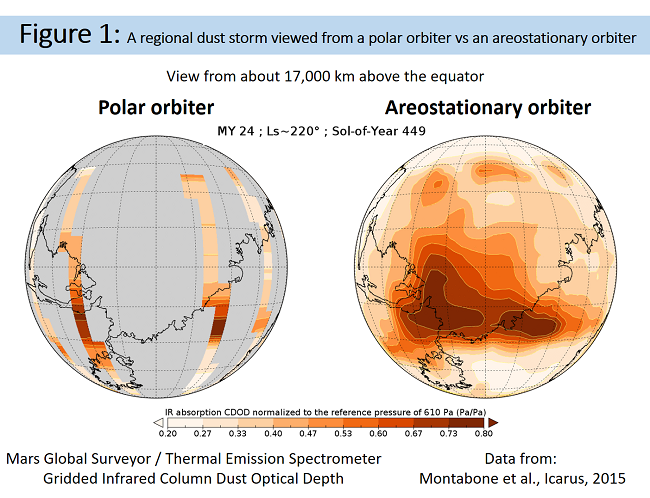
The Emirates Mars Mission (EMM), which entered Mars’s orbit in February 2021, is the first orbiter fully dedicated to the study of its climate. Thanks to its high, eccentric, low inclination orbit, it is also the first satellite that can reasonably observe the evolution of meteorological phenomena over multiple local times simultaneously, thus operating the transition from the mapping to the monitoring paradigm. Although unique so far, EMM alone cannot provide what has been identified as a high priority requirement to improve the spatiotemporal coverage of existing data and to enable future human exploration missions, i.e. global, continuous, and simultaneous monitoring, leading to forecasting of meteorological phenomena [6].
Quasi-global monitoring (excluding the polar regions) can be achieved by a constellation of areostationary platforms, i.e. satellites in equatorial, circular orbits in which the orbital period of the satellite matches the rotational period of Mars. The minimum number required for covering all equatorial longitudes is three [7]. The required number to cover all longitudes in a continuous latitude band extending from nearly 80°S to nearly 80°N with some large overlapping in longitude is four (Fig.2). If the areostationary constellation is coupled with at least one satellite in low polar orbit, the continuous (high cadence) and simultaneous (all locations at once) monitoring becomes nearly global [8].
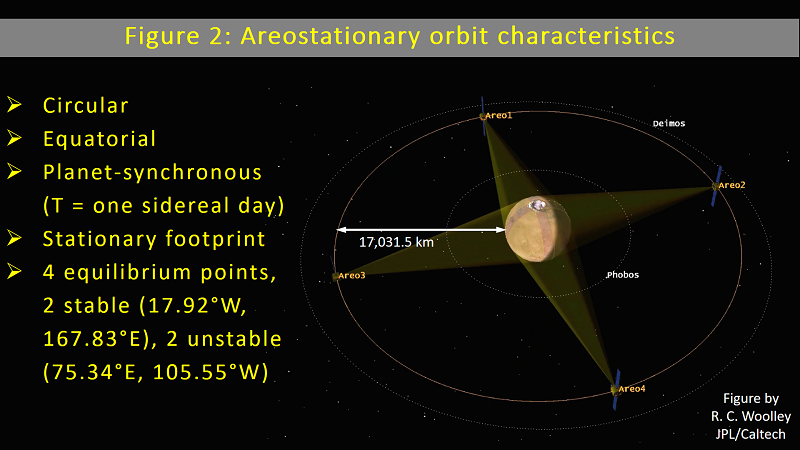
Areostationary observations would revolutionize Mars weather forecasting as geostationary satellite imagery did for Earth weather forecasting in the 1970s. The quasi-global, continuous, and simultaneous view that observations from an areostationary network provide would allow forecast initialization from atmospheric states that properly account for teleconnections, large-scale weather and dust events, tides, and other diurnally varying, global-scale phenomena (Fig. 3). Operational monitoring coupled to modelling will enable forecasting, allowing to take preventive actions and minimize risks. It will take several attempts to optimize an operational monitoring and forecasting system, primarily because extreme events such as dust storms attaining the planetary scale occur at irregular times. It is thus essential to send precursor missions aimed at developing the operative infrastructure well in advance of the first human mission.
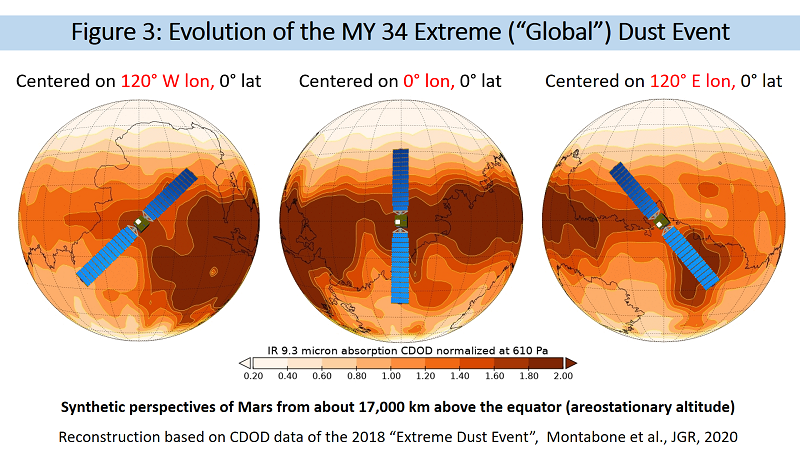
Areostationary platforms do not only offer advantages in meteorology. Satellites in areostationary orbit would spend nearly 75% of their time outside the bow shock of Mars, offering monitoring of the upstream solar wind at an unobstructed vantage point (Fig. 4). The high distance of an areostationary orbit from Mars could also allow for globally mapping the escape of atmospheric species in response to changes in upstream drivers, a task only partially fulfilled by EMM. Last but not the least, areostationary relay satellites could advance telecommunication capabilities for future robotic and human Mars missions far beyond current capabilities [9 to 11]. They are also ideal to support the communication requirements of a future generation of small, low-cost Mars science orbiters and be part of a Global Navigation Satellite System (GNSS), which would greatly improve mission safety and reliability for sustainable, long-term exploration [12]. See [7] for more information on the benefits and applications of satellites in areostationary orbit. Furthermore, the architecture of the constellation, and recent advancements on on-board computational capabilities, would enable significant degrees of autonomy, such as coordination of observations, event-driven operations, and goal-based monitoring.
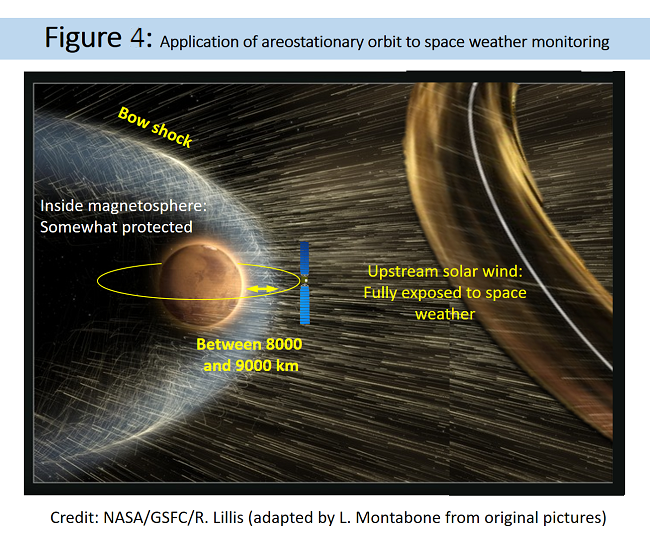
In order to fully shift paradigm from mapping to monitoring, therefore, we have developed a mission concept to send a constellation of at least three satellites in the second half of the current decade, place them in an areostationary orbit, and monitor atmospheric and space weather over the course of at least two Martian years. We name our concept MACAWS, which stands for "Monitoring Areostationary Constellation for Atmosphere and Weather in Space" (Fig. 5). The nature and objectives of this novel mission lend themselves to the use of SmallSats to reduce costs and accept higher risks, while maximizing impact. The scientific and operational achievements of this precursor mission will directly feed into the subsequent planning of larger-scale monitoring constellations.
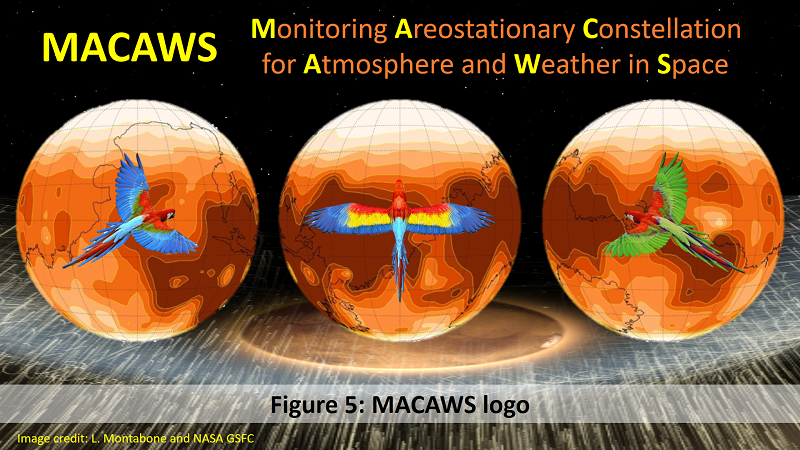
The stated goal of MACAWS is to be a low-cost, precursor, orbital mission to monitor atmospheric and space weather events continuously and simultaneously at most locations on the planet and in the upstream solar wind, in preparation for the human exploration of Mars. The scientific payload, mission architecture, and ConOps are defined accordingly (Fig. 6). The planned outcomes are a better scientific understanding of the dynamics of such events, and the development of an operational forecasting system in order to reduce the risks for humans when in orbit around Mars or on the ground.
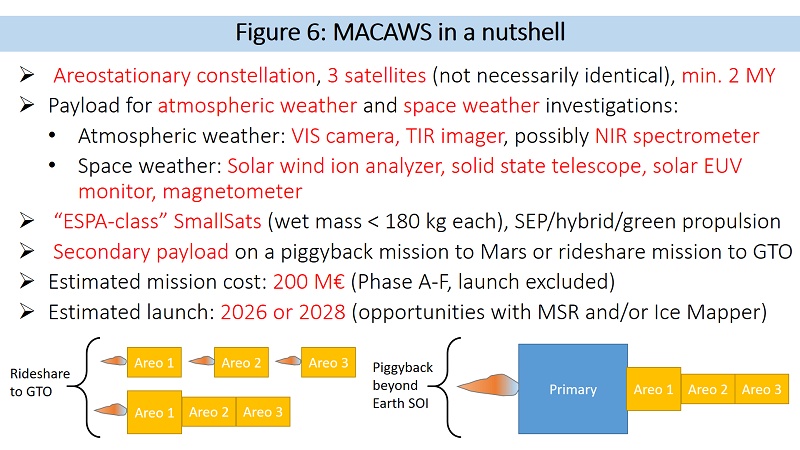
REFERENCES
[1] Glenar+ 2003 Icarus 161 297, https://doi.org/10.1016/S0019-1035(02)00046-5
[2] Zent+ 2016 JGR Plan. 121 626, https://doi.org/10.1002/2015JE004933
[3] Wolkenberg & Giuranna 2020 Icarus 113823, https://doi.org/10.1016/j.icarus.2020.113823
[4] Kleinboehl+ 2020 JGR Plan., e2019JE006115, https://doi.org/10.1029/2019JE006115
[5] Montabone+ 2020 JGR Plan., e2019JE006111, https://doi.org/10.1029/2019JE006111
[6] Banfield+ 2020 MEPAG Science Goals, https://mepag.jpl.nasa.gov/reports/MEPAGGoals_2020_MainText_Final.pdf
[7] Montabone+ 2020 White Paper PSA Decadal Survey, https://bitly.com/areowhitepaper
[8] Lillis+2021, Planet. Sci. J., in press
[9] Breidenthal+2018 SpaceOps Conf. 2426, https://doi.org/10.2514/6.2018-2426
[10] Edwards+2016 Proc. IEEE Aerosp. Conf., https://doi.org/10.1109/AERO.2016.7500680
[11] Lock+2016 Proc. IEEE Aerosp. Conf., https://doi.org/10.1109/AERO.2016.7500899
[12] Pirondini & Fernandez 2003 ESA Executive Summary, https://esamultimedia.esa.int/docs/Aurora/execsummaries/Interplanetary_GNSS.pdf
How to cite: Montabone, L., Capderou, M., Cardesin-Moinelo, A., Feruglio, L., Forget, F., Guerlet, S., Heavens, N., Lillis, R., Millour, E., Parfitt, C., Topputo, F., Vijendran, S., and Young, R.: A Paradigm Shift in Mars Meteorology: Towards Monitoring and Forecasting with Areostationary SmallSats, Europlanet Science Congress 2021, online, 13–24 Sep 2021, EPSC2021-625, https://doi.org/10.5194/epsc2021-625, 2021.

